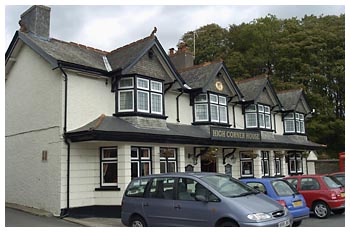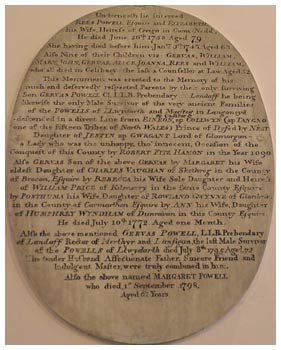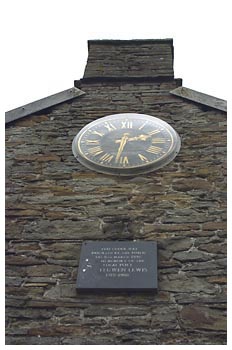
| Llanharran | |
| Llanharan is a parish covering some 3,000 acres and is dominated by the scarp ridge known as Garth Maelwg. The mountain provides splendid views over the Vale of Glamorgan and is steeped in folklore and history. Until a few generations ago, the Brenin Llwyd or Grey Monarch of the Mists was believed to inhabit this mountain and woe betide anyone caught in his grasp! A walk from Llanharan towards Llantrisant over the mountains will still take you to the site of "The Beacons", where before the 1700s the Militia met to muster and show arms. In later times this beacon would be lit to celebrate coronations. A short distance to the east is the location of the popular Egg Wells, whose sulphurous waters attracted hundreds of summer visitors to sample their curative properties and enjoy the fairground atmosphere. Perhaps those who tramped up to Caer Rocks would have claimed this the best walk of all. Many a mountain walker have disputed the origin of the words, "Dduw Cariad Yw"(God is Love) but have marvelled at the hundreds of smaller inscriptions carved on the rocks for posterity. | |
High Corner House |
If you descend the mountain and wish to see the lovely pre-industrial village begin at the Square, Llanharan. Look across at "The High Corner" which dates back at least to 1700. This pub was originally called "The Corner House" and by the 1770s it served as a chapel! The High Corner even before being enlarged in the mid 19th century was able to cater for the annual influx of sporting men of the chase, who came to Llanharan for the hunting season in the time of Richard Hoare Jenkins. Local farmers paid their rents here twice a year. In an age when some husbands over indulged in drink, wives were grateful to powerful preachers who denounced the demon drink. When Evan Roberts, the evangelist, came to the Square in 1905 it is said that he converted a whole rugby team! |
| Turn right at the pub and suddenly you will enter "an olde worlde" village that still charms the eye. This typical estate linear village on the banks of the Ewenny Fach must have been one of the largest and prettiest villages in the Border Vale with its fine local brown stone buildings and short terraces. Originally, it was entirely dependent on the squire and in its Victorian heyday comprised of a Smithy, a Dame School, a Malt House, a Shoemakers' "factory", a Corn Mill, the Church and some pretty thatched cottages. | |
| The Church of St Julius and Aaron | |
The Church is worth a visit though it is often locked. It was designed by John Prichard and built by J Rees of Bridgend in the Decorated Victorian Gothic Style. The cost of constructing it was just over a £1,000. Built chiefly of local pennant sandstone it has been described by Geoffrey Orrin as,
" …… one of Prichard's fine village churches". One of the earliest references to it is in 1563 when it was a chapel annexed to Llanilid but I think it is much older than this and probably belonged to the Tewkesbury Abbey possession in Glamorgan in 12th century. Right: General view of the church interior |
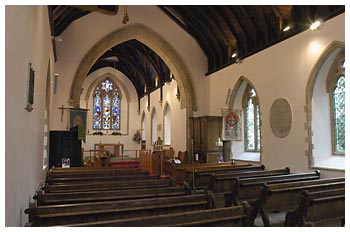 |
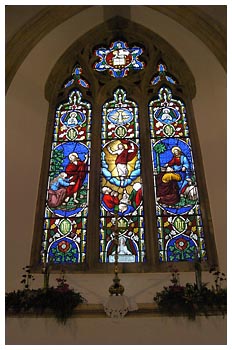 |
Some interesting people are buried in this Church. They include, "The Three Ladies of Lanelay" whom the 19th century diarist David Jones of Wallington's father described as the,
"oddest little women he had ever seen". The three ladies were Eleanor, Joan and Ann Bassett who were the last of the Bassets of Lanelay. They had lived in great seclusion at Lanelay Hall until their deaths. Surprisingly, four High Sheriffs of Glamorgan are at rest here with easily the most interesting of all being Richard Hoare Jenkins of Llanharan House, who died in 1856. It was he who played a role in suppressing the Merthyr Riots of 1831 but he found the execution of Dic Penderyn one of the most unpalatable of his civic duties. Left: Stained glass window of St Julius Church |
Do spend a minute or two reading the details on the Powell plaque. You will be able to see the name Margaret Powell who was the wife of a Llanharan Squire, the Reverend Gervase Powell. She was, in the opinion of David Jones, Sheridan's immortal comic character Mrs Malaprop. Jones quotes a delightful malapropism of hers that may well have referred to Llanharan House, |
Plaque on the wall of St Julius Church |
| Llanharan Schools | |
| When you return to the Square you will pass the old Blacksmith's on your right. Interestingly, the premises doubled up as a smithy and a school in mid Victorian times, just as the Bear Inn doubled up as a public house and school in nearby Llanharry . This school was run by a lady from Blackmill, who as well as being a needle-work specialist, taught the 3Rs. Soon this school moved to another building nearer to the Church, where the Scouts and Guides now meet. It was here the charismatic, "Bugs" Smith taught and this school may have been a National School. Mrs Sarah Holland Miles in her autobiographical account called "Dros yr Ysgwydd" had fond memories of this school and tells an amusing tale of how she was saved an embarrassing ordeal during an Inspection Day. Her task was to have knitted a stocking, which was to have been assessed by the Inspector. However, due to her nervousness, she could not complete the task and she was rescued whilst the inspector wasn't looking. Her kind-hearted teacher had tossed a half-finished stocking her way! In November 1890, a School Board was formed. Two years later a school was built in nearby Chapel Road for 200 pupils. This school served Peterston and Llanilid until in 1904 a new school was built in Brynna . When Llanharan had expanded westward especially after the Powell Duffryn Colliery was opened in the 1920s a third school was erected at Dolau. This third school was said at the time to possess the finest buildings and equipment in all Wales and the West Country. | |
| Writers Galore | |
If you should glance up at the Old Blacksmith's you will see a clock dedicated to the memory of Tegwen Lewis (right), a fine local poet who won 29 chairs and 3 crowns at local eisteddfodau. The clock is also a testimony to the fact that Llanharan takes its writers seriously. The village boasts a surprising number of writers. The earliest known writer was a gifted 15th century bard Rhys Brydydd of Blaen Cynllan and others include David Evans (Dewi Haran) (1812-1895), the Reverend John Morgan (1827-1903) and Sarah Holland Miles (1873-1965). In more recent times George Williams of Llanharan House, the Reverend Bob Morgan, John Harris, David Francis Les Servini and Terry Witts are all literary sons of Llanharan. Of the modern writers, perhaps Terry Witts deserves a special mention. He lived all his life in Llanharan and so took great pride in the history of his forefathers. This enthusiasm bore fruit in a series of books called "The Forgotten Years", which concentrate on the history of Llanharan from the Age of Squirearchy to the time when Coal was King. His text is supported by a treasure trove of old photographs. |
The clock and plaque on the old blacksmiths |
| Llanharan House | |
| About a mile down Llantrisant Road in a splendid setting stands Llanharan House, which has been the source of great interest to the local writers Terry Witts and David Francis. The house has been the home of 4 or 5 families including the Powells, the Jenkinses , the Blandys (latterly known as the Blandy Jenkins) and the Williamses. Rees Powell built the present house in the late 1740s, but was there a Ty Mawr (Big House) at Llanharan before the Powells arrived in 1700? Around the time of the Fire of London (1666) a gentleman called Evan Rees had a property where Llanharan House now stands, though it may have been a smaller house. Was Rees the first in a line of Squires of Llanharan? As with many landowners through the ages Llanharan squires also combined the hunting shooting and fishing life with dedicated public service. For example, John Blandy Jenkins served as Sheriff of Berkshire and Chairman of Glamorgan County Council from 1895-1915 and Mr George Williams and his son Owen have both served as High Sheriffs of Glamorgan in recent years. The owners of Llanharan House have over the years provided hospitality to some famous personalities including the King of Greece and Mrs Margaret Thatcher. | |
| The Mining Village | |
| To understand where and how Llanharan developed as a coal-mining village after 1885 you must now walk along the Dolau or Bridgend Road as it later became known. Leaving the Square you will cross the railway bridge and recognise the sort of terrace houses that you would have found in any mining valley. The Ewenny Fach valley itself was too narrow to absorb a rapid growth in population. This rise in numbers of incomers did not begin with the sinking of pits. It started with the coming of the South Wales Railway in 1850 and continued with the opening of iron mines near Pontyclun and Llanharry. After 1872 many tin workers also came to live not only in Llanharan village but in "Tin Works Row" near Tylagarw. But when three collieries started to expand to the north and west of Llanharan in the 1880s it was obvious that many more houses were need to accommodate the colliers and their families. Between 1891 and 1901 some 80 new houses were erected and by the turn of the century the expanding village was able to accommodate just over 1000 inhabitants. Of the incomers many arrived from England, especially from The Forest of Dean, where coal mining was in sharp decline. From 1900 until the P.D.'s Colliery closed in 1962 the area westward along the Bridgend Road became the commercial heart of a relatively flourishing mining village that survived even the Depression Years. As you walk along this main artery road look for clues to indicate its previous economic prosperity. I doubt whether you would ever guess that over a 60 year period this long street dissected an area that boasted a railway station, dairy, cinema, police station, an undertakers, 2 billiard halls, library, bakery, co-operative store, bank, garage, coal merchant, Post Office, tennis courts, several cafes, church hall, 5 chapels and around 20 shops selling all kinds of produce. Not all new settlers lived along this main road: the nouveau rich settled in Chapel Road, while many of the miners and other blue collar workers were housed in council accommodation on the road leading to Brynna. The glory days of Bridgend Road did not last long after the last colliery closed and by 1970 even prominent councillors were calling Llanharan "a dying village". Apart from Carmel Chapel and a few shops, all the above- mentioned amenities have disappeared one by one and for a while Llanharan became something of a ghost town. |
|
| Survival | |
| Llanharan did not die or sink into severe deprivation like some valley communities have done. It has been saved partly by a great deal of housing development in the last 30 years in Peterston parish, Llanharry Road and Bryncae. Its geographical proximity to the M4 and the prosperous Vale of Glamorgan also gave the village additional opportunities. The strong community spirit already prevalent at the local pubs and clubs was further enhanced in the 1990s with the erection of a vibrant Drop in Centre and Community Shop. These two developments have done much to keep the spirit of community alive and kicking. |
|
| More recently, a Regeneration Committee started asking the public to prioritise the pressing needs of both young and old in the area. The closure of the old Rugby club and its transformation into a state-of-the-art club-house (right) on the site of the former British Legion has helped to provide premises for an improving club that in 2004 was promoted to the Premier Division of the Welsh Rugby Union. The renovation of the Pensioners Hall also secures a future meeting place for older residents.
Right: Llanharran RFC |
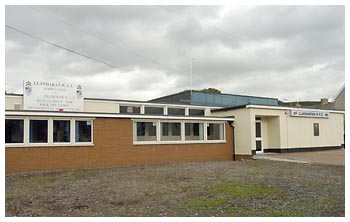 |
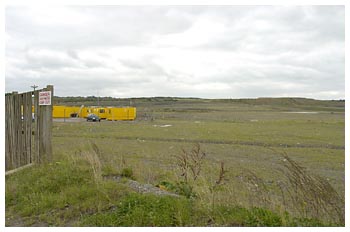 |
Finally, the establishment of the Dragon Film Studios and Leisure Complex at the old Llanilid opencast site when completed should further regenerate the economy of the village.
Left: The site of the old opencast mining operations which is in the process of being turned into a huge film making complex. One of the largest outside of the USA |
| Peterston-super-Montem | |
| Peterston-super-Montem, as its name implies, is an upland parish situated about 6 miles north east of Bridgend and separated from Llanharan and Llanilid by the tributary stream called the Ewenny Fach.Perhaps the best way to get an impression of what the parish looked like before Brynna was developed in the late 19th century is on foot. If you were to walk from Gelli Fedi Road, Brynna up to the old church called St Peter's, (Llanbad) that lies in ruins on the hillside called Mynydd Portref you would be able to gain a view of what the area may have looked like in a previous age. Although the scenery is undoubtedly splendid, one gets a feeling of strange isolation and you begin to wonder why a church was ever built on this spot. | |
| No one is sure whether it is a Celtic or Norman church. But it must have required a strenuous effort to attend divine service over the centuries here. However, it may not have been quite as isolated as it appears for it stood only yards from the old ridge way road that ran from Llantrisant to Neath. The church was popular with the bards of Glamorgan and with couples wanting to get married. Amazingly, between 1736 and 1740 fourteen marriages were performed there, one more than at the mother church at Llangrallo at Coychurch. | 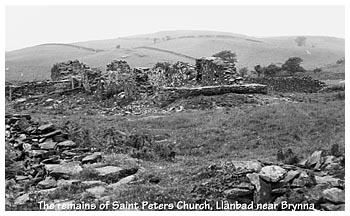 |
| Early Economy | |
| If one looks down towards Brynna and Pencoed one realises that a strictly pastoral economy with scattered farmsteads was practised from the earliest times. The boundaries of Peterston after the Norman conquest of Glamorgan coincided with the manor of Newland, which was held successively by the lords of Coity. But the manors of Llanharry and Peterston could not have been more different. The 1631 Surveys make it clear that, unlike Llanharry, there was no village, no copyhold land and customary tenants, little arable agriculture and no coal mining. At Llanharry the coal was near the surface and exploited by the Sidneys in Elizabeth 1's reign, but at Peterston the seams were too deep. There were some villages along the ridge way road, but there was no sign of a village near the old church or elsewhere in the parish. The only mill located in the parish in 1631 was to be found in Llanharan village. Both parishes obviously shared the same mill. The lack of a village meant that the old St Peter's church became redundant and ruinous by the early years of the 19th century. So in 1833 it was decided to build a new church in a more accessible site not far from "The Eagle" inn. Mr E. Davies of Tregroes erected it at a cost of £250. In order to preserve historical continuity the builders reclaimed the bell, the font and the Elizabethan chalice from the old church. During later restoration work in the 1880s even the stones from Llanbad old church were carted down the mountain to improve the new building. If you had come to the parish twenty or so years after the new church was built you would still have found no Brynna. There had been some early 19th century coal mining at Nant Ciwc, but the only building in Brynna in 1843 was The Eagle. Nearby you would have found Gelli Fedi Mill, Hendrewen Mansion and Brynna Gwynion, which was an area of open wasteland that extended as far as the present village. There was of course Bethlehem Chapel and a few cottages in Llanharan itself, west of the Ewenny Fach. In actual fact the whole parish contained only about 40 homes in 1881. |
|
| Brynna | |
| It was the sudden exploitation of the southern outcrop between 1881 and 1901 at a number of local collieries and drifts, especially South Rhondda, Brynna Gwynion and Hendrewen that saw Brynna mushroom into a thriving industrial village. The name Brynna is used on church records about 1897, so can we assume that the new village was first called Brynna Gwynion and later shortened to Brynna? By 1901 the population had exploded to 600 (double that of 1891) and there were over 100 dwellings there, with more soon to come. At first, miners came from other parts of Glamorgan, but soon colliers from England, especially from The Forest of Dean, joined them. It is interesting to note the integration of Welsh and English families who were the first occupants of William Street in Brynna. Some examples of family names include: - Combes, Jones, Gibby, Williams, Young, Walters, Morgan, Hill, Ruck, Germain. Perhaps they may still be relatives of these families still living in Brynna! To slake the thirst of some of these immigrant workers The Eagle was rebuilt and was sited one house away from the old pub. To cater for the spiritual needs of the growing village; Brynna Methodist Chapel was built in 1908 to provide choice of worship for the growing community. There was change too in education facilities. There had been earlier schools in Peterston. For example, a Griffith Jones Circulating School was established in the parish in 1747 but was sited in Llanharan village. This school probably served both communities for it boasted 49 pupils. A Dame School had existed in the 1870s and 80s and was kept by a genteel lady called Mrs Maria Habbakuk, who was a member of the famous Guest family of Dowlais. This school was probably located in 3 cottages on the road to Pencoed, a few hundred yards beyond the Mountain Hare. It was then called Godre or Habbakuk's Row. In 1904 children no longer had to travel to Llanharan for their schooling. In that year, due to the rapid expansion of the village, a new school was built, which was opened by Mrs Blandy Jenkins of Llanharan House. Brynna School then accommodated 160 children and Mr D. Emlyn Davies was its first Head Teacher. The year 2004 witnessed the centenary of the school. The unveiling of a memorial clock on Brynna Square, a Centenary Ball, which was attended by famous pupils like Stan Stennett and David Hughes and hundreds of others, the Edwardian School Day and the winning of a prestigious History Award, marked the celebrations. Should anyone want to know more about Brynna's history, you can read the late T.J. Witt's "Forgotten Years" series. He wrote enthusiastically about mining, agriculture, schools and sport. His work records the glory days of Brynna soccer teams just after the war when they won the much coveted South Wales and Monmouthshire Amateur Cup in 1949. He also writes about the late Evan Bowen who was an outstanding goalkeeper and darts player. |
|
| Brynna Today | |
The older streets of the industrial village are still easily recognisable, adjacent to the Eagle Hotel. Brynna, however, has undergone a rapid second stage of development over the past 40 years, which is completely unrelated to coal mining. There has been considerable house building in Brynna itself and further west at The Mountain Hare.
Right: The Church at Brynna Below:In 2004 the school celebrated its 100th anniversary and this picture shows the present headmaster with past pupils stood in front of a mural on the school depicting the past, present and future. |
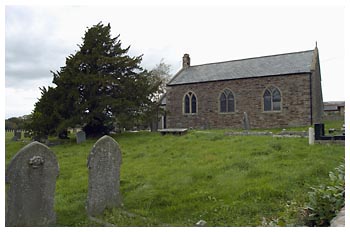 |
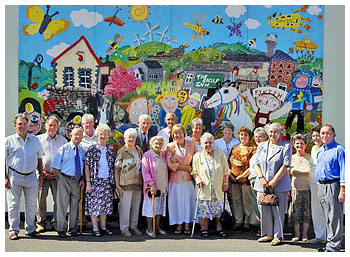 |
A young thriving community requires greater leisure facilities. The two local inns and a modern Community Centre have provided this, where weekly round of social and sporting activities are enjoyed. The excellently managed Junior and Senior Football Clubs have recently benefited from an extra football pitch and a multi-sport floodlit hard court area at the Recreation Field. The Church and Methodist Chapel still play an active role in the life of the village and with a community focused Primary School, an active Senior Citizens' Association and a Complex for pensioners and disabled people at Tanybryn, the needs of both young and old are quite well catered for. |
| Llanilid | |
| The easiest way to study the history of the parish is to visit the church of St Ilid that stands in lonely isolation in the fields. It has to be approached via a closed gate and a short pathway. If you look carefully at the foot of the north wall of the nave on the outside you may spot some ancient foundations of an earlier church. There has been much controversy over the centuries about the age of Llanilid Church some of which has been quite fanciful. It was once believed to be the oldest church in Britain! It seems likely that soon after the Norman conquest of Glamorgan the church was re-dedicated to St Julitts or Julitta and some argue that Julitta is another form of Ilid. If so then Ilid was a woman! Not far from the church is a little wood and in it was a Rag Well. |
|
Sick people would visit it and toss their garments into the water, which they believed would take away their illnesses. The church has some interesting medieval earthworks adjacent to it. As you leave the church you cannot miss a very impressive ring motte. The advancing Normans may have constructed this as they pushed their way northward against a stubborn Welsh resistance. If you climb over the coffin stile and along a footpath southwest from the church you will pass some more earthworks called "Gadlys". Scholars now believe that this site was more of an administrative centre rather than a castle. The "Gadlys" may have replaced the earlier ring motte
Right: St. Ilid Church Llanilid |
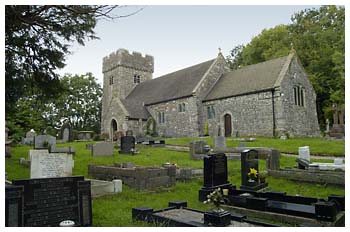 |
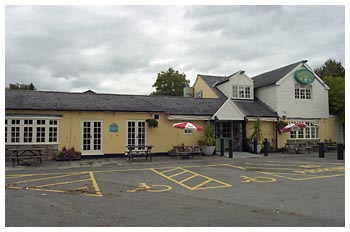 |
Woodland, marsh and heath dominate the landscape naturally discouraged a corn-growing and settled village economy. There is one important exception to this pattern, namely, the medieval manor of Milton, which had fertile arable land in it. Milton Manor was scattered throughout Glamorgan and belonged to the famous knights of St John of Jerusalem before 1338. This romantic order may even have had a hospice for travellers here.
Left: The Old Mill/Harvester |
| The Llanilid portion was certainly based on a water mill, and even as late as the 19th century there was a working mill, a smithy, some cottages and an inn called "The Fox and Hounds". As one imbibes a wee drop of the elixir of life in the present "Old Mill/ Harvester" that stands on the exact site today, one can reflect on Llanilid's colourful history and its links with the exploits of the Knights of St John. The Hearth Tax Returns of Charles II's reign tell us that in 1671 there were far more houses and farms here than in the Victorian Age. But there was no manor house then or later. The biggest house was Trallwn with only 4 hearths. Few people realise that this sleepy little hamlet was in the mid 18th century one of the cradles of Methodism in Wales. There was a society established here which was visited by the great Howel Harris. Indeed, we read in his Journals that on April 27th 1745 he visited Penprisk and "nr Rhythyn" and later he was at Pantrhythin. We know that the Methodist cause lingered on at Trallwn for thirty years or so, for in 1771 there were still a few Methodists in the parish as Church records of the time indicate. St Ilid's church was badly neglected for the next two centuries, partly because most landowners were absentee ones. By 1880 the church tower was exposed to the elements, the bell was unsafe and the fabric about to fall down. Thanks to the energies of the Rector, the Reverend John Morgan, John Prichard the Diocesan architect restored the church in 1882-3 for some £875. John Morgan's tombstone, not far from the church gate, does not mention this, or the fact that he was a poet of some ability, whose "Welsh Home", pleased both Gladstone and Lord Tennyson. Llanilid witnessed decline both in the number of houses and total population from mid Victorian times. In 1901 there were only 95 people living in Llanilid mostly in scattered farms and labourers' cottages. This economic decline continued well into the 20th century. However, the 1970s heralded the introduction of Open Cast Mining, the construction of the M4 and later the recreational facilities of the St Mary Hill Golf Club and the Old Mill that has gone some way to help arrest this decline. But the greatest change to effect Llanilid in all its history is just around the corner as the forthcoming £330 million Dragon Film Studios and Theme Park will help regenerate the whole area. It is hoped that the rich habitat of local wild life, especially of birds, will not be threatened by the vast changes. |
|
